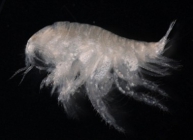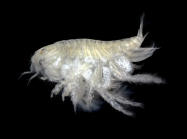WoRMS taxon details
Urothoe brevicornis Spence Bate & Westwood, 1862
103226 (urn:lsid:marinespecies.org:taxname:103226)
accepted
Species
marine, brackish, fresh, terrestrial
recent only
Bate, C. S. & J. O. Westwood. (1861-1863). A History of the British Sessile-eyed Crustacea. Vol. 1. <em>John Van Voorst, London.</em> 507 pp., available online at https://www.biodiversitylibrary.org/bibliography/1936#/summary
page(s): 198 [details]
page(s): 198 [details]
Taxonomic remark The use of the name ‘Spence Bate’ instead of ‘Bate’ is discussed herein. See page 201.
Description An amphipod with a rounded, broad and robust body. Can reach lengths of 7 mm. The black eyes are very large in males and...
Distribution In the 1976-1986 period Urothoe brevicornis was observed outside the coastal area with a low distribution frequency and in...
Distribution U. brevicornis is a common inhabitant of the offshore part of the Southern Bight and is found in high densities at the...
Distribution frequent, but rarely numerous
Taxonomic remark The use of the name ‘Spence Bate’ instead of ‘Bate’ is discussed herein. See page 201. [details]
Description An amphipod with a rounded, broad and robust body. Can reach lengths of 7 mm. The black eyes are very large in males and...
Description An amphipod with a rounded, broad and robust body. Can reach lengths of 7 mm. The black eyes are very large in males and almost adjoining on top of the head. In females the eyes are moderately large and reniform. The head has a small rostrum. The body is yellowish white. [details]
Distribution In the 1976-1986 period Urothoe brevicornis was observed outside the coastal area with a low distribution frequency and in...
Distribution In the 1976-1986 period Urothoe brevicornis was observed outside the coastal area with a low distribution frequency and in low densities (maximum 140 ind./m2). A higher distribution frequency, higher densities (maximum 350 ind./m2) and observations near the western coastal zone were characteristic of the species in the 1994-2001 period. [details]
Distribution U. brevicornis is a common inhabitant of the offshore part of the Southern Bight and is found in high densities at the...
Distribution U. brevicornis is a common inhabitant of the offshore part of the Southern Bight and is found in high densities at the Brown Bank and west of the Voordelta. In contrast to U. poseidonis, U. brevicornis occurs more offshore in the Southern Bight and is absent from the Dogger Bank. In the Delta area the species is found only in the marine part of the Oosterschelde. North of the 30 m isobath this amphipod is absent. [details]
Distribution frequent, but rarely numerous
Distribution frequent, but rarely numerous [details]
Horton, T.; Lowry, J.; De Broyer, C.; Bellan-Santini, D.; Copilas-Ciocianu, D.; Corbari, L.; Costello, M.J.; Daneliya, M.; Dauvin, J.-C.; Fišer, C.; Gasca, R.; Grabowski, M.; Guerra-García, J.M.; Hendrycks, E.; Hughes, L.; Jaume, D.; Jazdzewski, K.; Kim, Y.-H.; King, R.; Krapp-Schickel, T.; LeCroy, S.; Lörz, A.-N.; Mamos, T.; Senna, A.R.; Serejo, C.; Souza-Filho, J.F.; Tandberg, A.H.; Thomas, J.D.; Thurston, M.; Vader, W.; Väinölä, R.; Valls Domedel, G.; Vonk, R.; White, K.; Zeidler, W. (2025). World Amphipoda Database. Urothoe brevicornis Spence Bate & Westwood, 1862. Accessed through: World Register of Marine Species at: https://www.marinespecies.org/aphia.php?p=taxdetails&id=103226 on 2025-04-11
Date
action
by
![]() The webpage text is licensed under a Creative Commons
Attribution 4.0 License
The webpage text is licensed under a Creative Commons
Attribution 4.0 License
Nomenclature
original description
Bate, C. S. & J. O. Westwood. (1861-1863). A History of the British Sessile-eyed Crustacea. Vol. 1. <em>John Van Voorst, London.</em> 507 pp., available online at https://www.biodiversitylibrary.org/bibliography/1936#/summary
page(s): 198 [details]
basis of record Bellan-Santini, D.; Costello, M.J. (2001). Amphipoda. <em>in: Costello, M.J. et al. (Ed.) (2001). European register of marine species: a check-list of the marine species in Europe and a bibliography of guides to their identification.</em> Collection Patrimoines Naturels 50: pp. 295-308. (look up in IMIS) [details]
page(s): 198 [details]
basis of record Bellan-Santini, D.; Costello, M.J. (2001). Amphipoda. <em>in: Costello, M.J. et al. (Ed.) (2001). European register of marine species: a check-list of the marine species in Europe and a bibliography of guides to their identification.</em> Collection Patrimoines Naturels 50: pp. 295-308. (look up in IMIS) [details]
Other
context source (Schelde)
Maris, T., O. Beauchard, S. Van Damme, E. Van den Bergh, S. Wijnhoven & P. Meire. (2013). Referentiematrices en Ecotoopoppervlaktes Annex bij de Evaluatiemethodiek Schelde-estuarium Studie naar “Ecotoopoppervlaktes en intactness index”. [Reference matrices and Ecotope areas Annex to the Evaluation methodology Scheldt estuary Study on “Ecotope areas and intactness index”. <em>Monitor Taskforce Publication Series, 2013-01. NIOZ: Yerseke.</em> 35 pp. (look up in IMIS) [details]
context source (BeRMS 2020) Bio-environmental research group; Institute of Agricultural and Fisheries research (ILVO), Belgium; (2016): Macrobenthos monitoring in function of dredge disposal monitoring in the Belgian part of the North Sea. [details]
additional source Bate, C. S. (1863). Catalogue of the Specimens of Amphipodous Crustacea in the Collection of the British Museum. <em>British Museum Natural History: London.</em> i-iv + 1-399, pls. 1-58., available online at https://doi.org/10.5962/bhl.title.20901
page(s): 116 [details]
additional source Bachelet, G.; Dauvin, J.-C.; Sorbe, J. C. (2003). An updated checklist of marine and brackish water Amphipoda (Crustacea: Peracarida) of the southern Bay of Biscay (NE Atlantic). <em>Cah. Biol. Mar.</em> 44(2): 121-151. (look up in IMIS) [details] Available for editors [request]
[request]
additional source Muller, Y. (2004). Faune et flore du littoral du Nord, du Pas-de-Calais et de la Belgique: inventaire. [Coastal fauna and flora of the Nord, Pas-de-Calais and Belgium: inventory]. <em>Commission Régionale de Biologie Région Nord Pas-de-Calais: France.</em> 307 pp., available online at http://www.vliz.be/imisdocs/publications/145561.pdf [details]
additional source Lincoln, R. J. (1979). British marine Amphipoda: Gammaridea. <em>British Museum (Natural History).</em> 658 pp. (look up in IMIS) [details] Available for editors [request]
[request]
context source (BeRMS 2020) Bio-environmental research group; Institute of Agricultural and Fisheries research (ILVO), Belgium; (2016): Macrobenthos monitoring in function of dredge disposal monitoring in the Belgian part of the North Sea. [details]
additional source Bate, C. S. (1863). Catalogue of the Specimens of Amphipodous Crustacea in the Collection of the British Museum. <em>British Museum Natural History: London.</em> i-iv + 1-399, pls. 1-58., available online at https://doi.org/10.5962/bhl.title.20901
page(s): 116 [details]
additional source Bachelet, G.; Dauvin, J.-C.; Sorbe, J. C. (2003). An updated checklist of marine and brackish water Amphipoda (Crustacea: Peracarida) of the southern Bay of Biscay (NE Atlantic). <em>Cah. Biol. Mar.</em> 44(2): 121-151. (look up in IMIS) [details] Available for editors
additional source Muller, Y. (2004). Faune et flore du littoral du Nord, du Pas-de-Calais et de la Belgique: inventaire. [Coastal fauna and flora of the Nord, Pas-de-Calais and Belgium: inventory]. <em>Commission Régionale de Biologie Région Nord Pas-de-Calais: France.</em> 307 pp., available online at http://www.vliz.be/imisdocs/publications/145561.pdf [details]
additional source Lincoln, R. J. (1979). British marine Amphipoda: Gammaridea. <em>British Museum (Natural History).</em> 658 pp. (look up in IMIS) [details] Available for editors
 Present
Present  Present in aphia/obis/gbif/idigbio
Present in aphia/obis/gbif/idigbio  Inaccurate
Inaccurate  Introduced: alien
Introduced: alien  Containing type locality
Containing type locality
From editor or global species database
Taxonomic remark The use of the name ‘Spence Bate’ instead of ‘Bate’ is discussed herein. See page 201. [details]Unreviewed
Biology U. brevicornis shows two types of movement, swimming and burrowing into the sediment (Watkin, 1939a). U. brevicornis reproduces from summer to autumn. Little is known of its life cycle. It probably lives for one to two years. Generally, breeding behaviour of infaunal amphipods is influenced by location. In deeper waters the spring rise in temperature initiates breeding, while in shallower waters it is induced by tidal phasing (Wolff, 1973; Fish & Fish, 1989).
The species of the genus Urothoe may be considered selective deposit feeders. They feed by cleaning sand grains from adhering micro-organisms and detritus (Nicolaisen & Kanneworff, 1969). [details]
Description An amphipod with a rounded, broad and robust body. Can reach lengths of 7 mm. The black eyes are very large in males and almost adjoining on top of the head. In females the eyes are moderately large and reniform. The head has a small rostrum. The body is yellowish white. [details]
Distribution In the 1976-1986 period Urothoe brevicornis was observed outside the coastal area with a low distribution frequency and in low densities (maximum 140 ind./m2). A higher distribution frequency, higher densities (maximum 350 ind./m2) and observations near the western coastal zone were characteristic of the species in the 1994-2001 period. [details]
Distribution U. brevicornis is a common inhabitant of the offshore part of the Southern Bight and is found in high densities at the Brown Bank and west of the Voordelta. In contrast to U. poseidonis, U. brevicornis occurs more offshore in the Southern Bight and is absent from the Dogger Bank. In the Delta area the species is found only in the marine part of the Oosterschelde. North of the 30 m isobath this amphipod is absent. [details]
Distribution frequent, but rarely numerous [details]
Habitat Urothoe brevicornis is typically found in medium to coarse-grained sediments (median grain size > 200 μm). The mud content remains low (chiefly < 10%). The highest relative occurrence (± 40%) is reached in sediments with a median grain size of 250 to 400 μm. [details]
Habitat U. brevicornis is widely distributed in clean, medium to fine sand as found in the Southern Bight. [details]
Morphology U. brevicornis has a rounded, broad and robust body. It can reach up to about 7 mm in length. The eyes are very large in males and almost adjoining on top of the head. In females the eyes are moderately large and reniform. The head has a small rostrum. The body is yellowish white and the eyes are black (Lincoln, 1979; Fish & Fish, 1989; Hayward & Ryland, 1990). U. brevicornis differs U. poseidonis (q.v.) in having a rnuch smaller carpus of the fifth pereopod. [details]
Publication date Bate, 1861 [details]
| Language | Name | |
|---|---|---|
| Dutch | bulldozerkreeftje | [details] |


